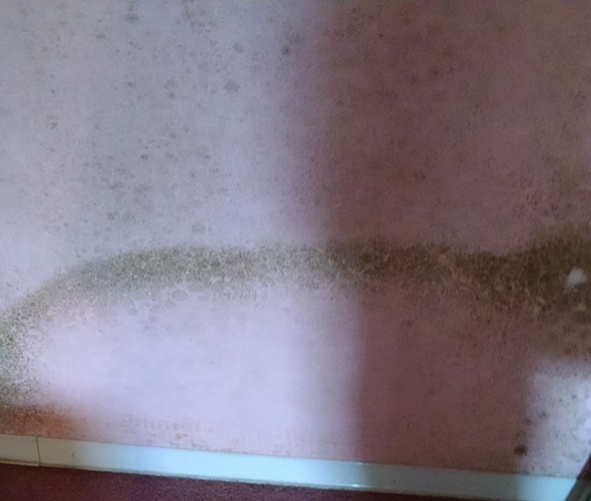Find a Mold Specialist Now
Click or Call, Toll-Free 24/7
Gliocladium Mold
in your home
Gliocladium is a fast-growing strain of mold found all around the world. Initially it is white in color but then it changes to a pinkish hue and finally becomes green. It has a soft, downy texture. In a home, it might be found growing in things like carpet, insulation, water-damaged mattresses, or damp papers.
While it can be found all around the world, it's not one of the more common strains of mold. Information about its toxicity and associated health problems is limited. However, it is closely related to another very common and well-known strain of mold, penicillium, and much is known about the effects of penicillium on health. You can read more about penicillium and related health problems.
Health Problems Associated with Gliocladium
 Mold on wall
Mold on wallLike penicillum and many other types of mold, this strain can cause respiratory problems and allergic reactions. Chronic sinusitis is common, as is inflammation of the lungs. Coughing, sneezing, sore throats, headaches, sinus pressure and pain, bronchitis, and even pneumonia may develop as a result of exposure to mold. People with asthma may experience a worsening of symptoms as well as an increase in frequency, duration, and severity of asthma attacks. Allergic reactions to mold can trigger respiratory symptoms as well as an itchy rash or hives.
People with asthma and other respiratory disorders are at increased risk for mold-related health problems, as are those with disorders affecting the immune system. Small children and elderly people are also at increased risk, but it's important to understand that anyone can get sick from exposure to mold. Even pets can get sick from exposure to mold in the home.
Damage to the Home Due to Gliocladium
Like all strains of mold, this one will do significant damage to your home unless it is removed quickly. Of course, the longer mold remains in the home, the more likely you are to develop mold-related health problems, as well.
This kind of mold is typically found on porous materials. These include things like:
- drywall
- the insulation inside of walls
- carpet
- the padding underneath carpet
- paper, including books
- mattresses
- sofas and other upholstered furniture
Mold cannot be adequately removed from porous materials like these. Microscopic amounts of mold get into the tiny holes, or pores, and even if the materials look clean, small amounts of mold remain that can later grow and spread. Because of this, porous materials like these must be removed and replaced in order to rid the home of mold.
As you might imagine, it can be a lot of work to remove mold from the home and it can also be costly. It's not so hard to carry out a moldy mattress and buy a new one, but if you have to remove drywall and insulation and replace that, you're looking at a good amount of work.
The work must be done carefully because things like cutting into drywall or pulling up carpet scatter mold spores into the air, where they can easily drift into other areas of the home. Then you can end up with mold in previously mold-free areas, making matters worse.
In addition, mold spores are easily inhaled, increasing your risk of developing mold-related health problems. Personal protective equipment, including N-95 face masks, must be used when removing gliocladium or other strains of mold from the home to protect against exposure to potentially-harmful mold spores. You can learn more about personal protective equipment for use when removing mold.
If you're at increased risk for mold-related illness, the U.S. Environmental Protection Agency (EPA) recommends consulting your physician before beginning the mold removal process in your home. Your doctor may advise you to arrange for someone else to do the work for you, to prevent making your symptoms worse. In some instances, your doctor may even recommend you not return to your home until the mold has been removed.
For Help with Mold Removal
If you need help with mold removal, or if you would just like the opportunity to ask an experienced professional some questions about the mold removal process, you can schedule a free consultation in your home with a mold remediation professional. Even if you plan to do the work yourself, you can benefit from some expert advice, including important safety tips. There is no cost to you and no obligation on your part, so you have nothing to lose. To find qualified mold remediation professionals offering free in-home consultations in your area, just follow the link provided.
Return From Gliocladium To Our Main Mold Types Page
Privacy Policy Terms and Conditions Accessibility Do Not Sell My Information Disclaimer Contact Us




